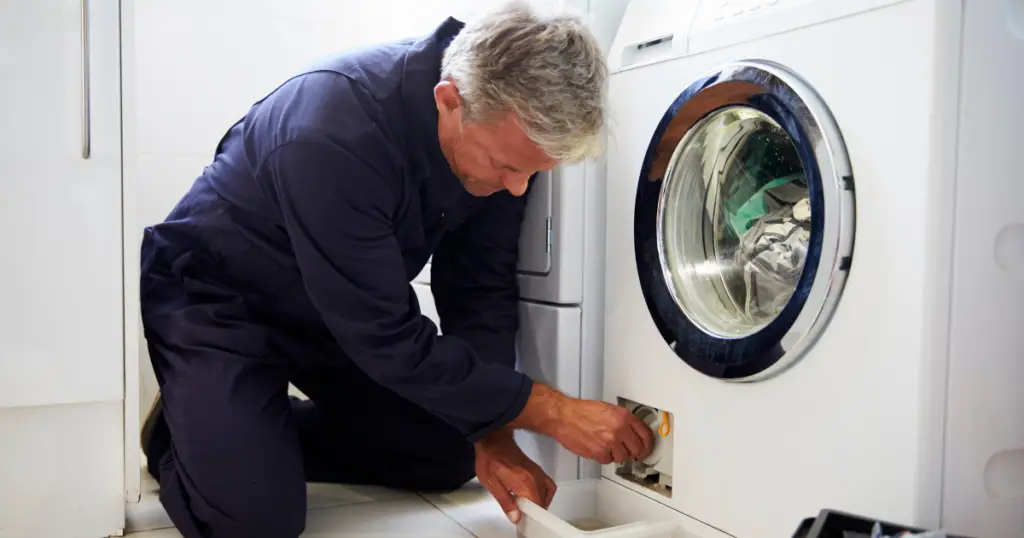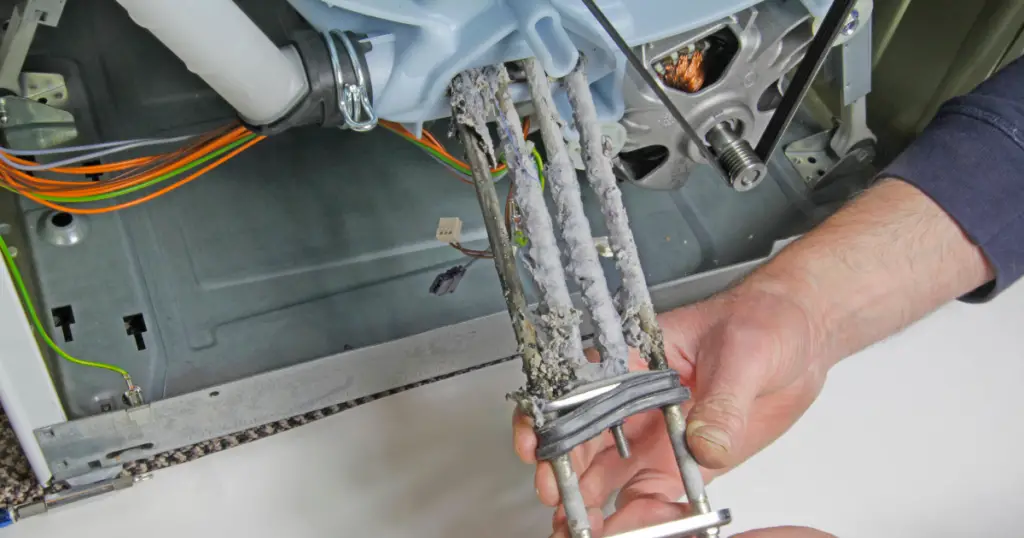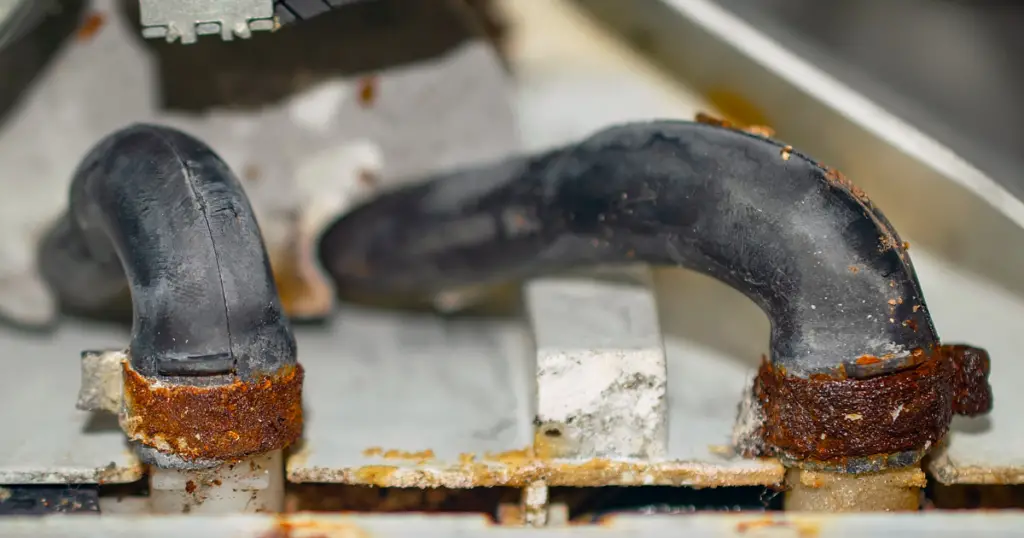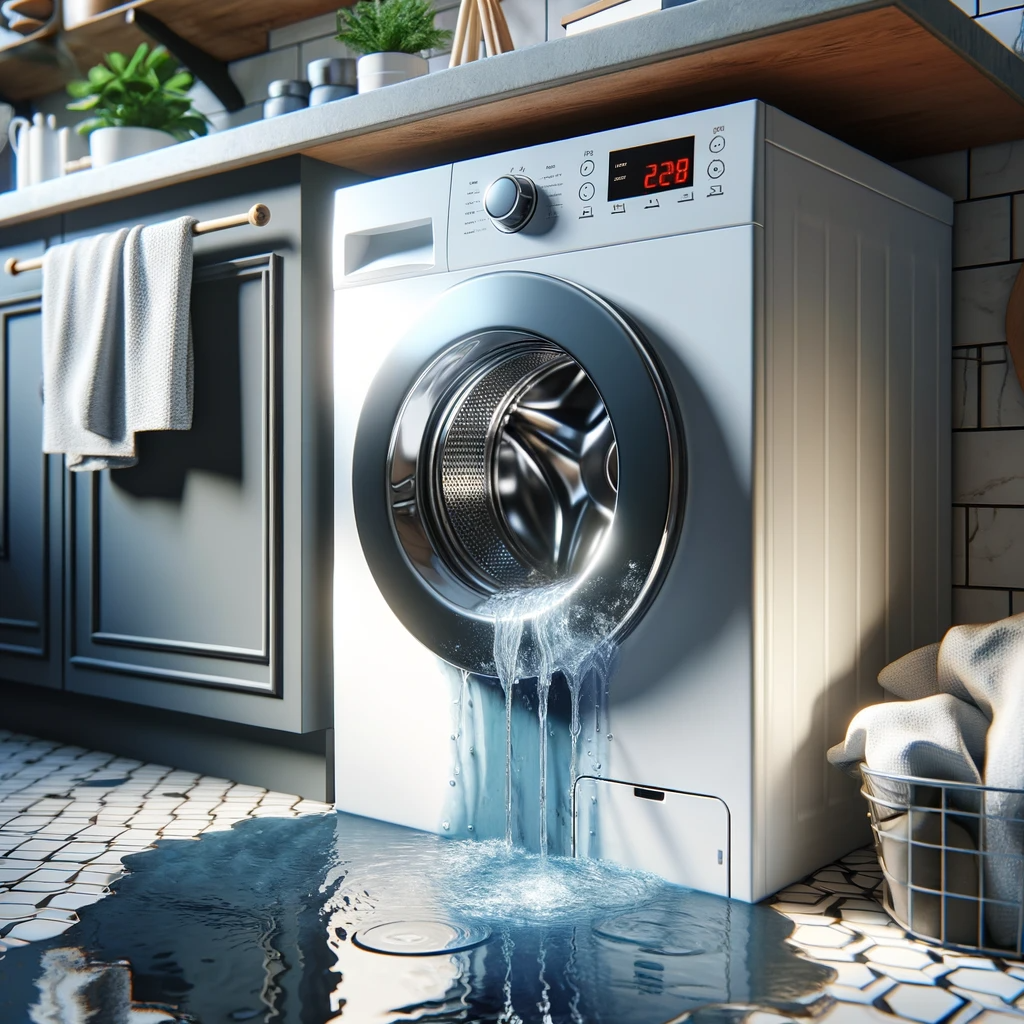Is your washing machine leaking? You may have noticed a puddle forming near the bottom of your washer. Don’t worry, you’re not alone! Many homeowners face this issue from time to time and it could mean that something is wrong with the internal mechanisms of your appliance.
In this article, we will discuss what causes the bottom of washing machines to leak, what to do if it occurs, and how to prevent it from happening in the future.
Why is my washing machine leaking?
If you notice that your washing machine is leaking, it is important to take the necessary steps to prevent any further damage. First, shut off the power and unplug the machine from the wall. Ensure that it is level and turn off any related taps. After that, begin assessing what could be causing the issue.

Washer Machine Leaking From Underneath
Before you contemplate replacing or fixing your home washing machine, take a moment to discover what exactly is causing the bottom to leak.
Water Pump
If you find that water is leaking from the bottom of your washing machine, it could be an indication that the water pump is faulty. The pump is necessary to move water in and out of the washing machine and if it isn’t working properly, liquid may escape through leaks. The machine may have separate pumps for draining and circulating the water; or a single pipe used for both purposes.
- If you have a leaky water pump, first check that all the hoses connected to it are securely attached and inspect them for any wear or tears. Additionally, make sure the pump is free of any build-up of dirt or debris that could cause water to be blocked and back up into your machine. If there is a buildup, clean it out with a soft brush or cloth. Lastly, check for any loose screws or debris in the pump itself that could impede water flow and cause further issues down the line.
Front Load Washer Drum
A front-load washing machine typically features both inner and outer drums. The outer drum is usually composed of two pieces that are held together by bolts. Parts of the washer, such as the seams in these parts, may become worn or damaged over time and can cause leaks.
- To keep your front-load washer drum running smoothly, make sure you clean it regularly with either an all-purpose cleaner or a vinegar solution. You should also check for any signs of wear or damage on the drum itself, such as cracks or holes, which could lead to further damage to your machine if left unchecked. A professional should be called in to replace the drum if necessary.
Faulty gaskets
A gasket plays an important role in keeping your washing machine water-tight. If the gasket has worn spots or is not properly secured, it can cause leaks that can lead to damage and costly repairs.
- To fix this issue, first, remove the front cover of the washer and then tighten all the bolts so that the gasket sits snugly against the frame. Doing this should ensure that no water gets inside, providing a secure seal and eliminating any potential leaks.
Door Seals
Door seals can be another source of water damage in your washing machine. The seal around the door is responsible for keeping the water inside and preventing it from leaking out during a cycle. Look for any signs of wear or tears, as well as any gaps that could be letting water seep out.
It’s important to replace this seal as soon as possible – not only will it prevent further water damage but could also lead to electrical and fire hazards. Make sure to check the fit and make sure that the seal is secure before use. Additionally, check for any corrosion or perforations in the rubber gasket on the door, which can indicate it may need to be replaced.
- To fix a door seal leak, it’s important to replace the seal with a new one that fits well and is secure. Make sure to check for any wear or tears in the old seal, as well as any gaps that could be letting water seep out.
Washing Machine Hose leaking
One of the most common causes for a washer that leaks from the bottom is a leak in the fill and drain hoses. Check all the hoses for any signs of potential wear, like cracks or tears, and replace them right away if needed. Make sure to inspect the inside and outside of each hose for any kind of damage before using it and that they are properly secured in their fittings.
In most washers, there will be an external hose connecting the appliance with the water source from outside, as well as internal hoses leading within. To access these, you have to remove the upper part of the cabinet and examine them thoroughly for perforations, corrosion, or abrasions. Additionally, ensure that all connections are securely tightened to avoid any potential leakage during water cycles.
- To fix a leaking hose, it’s important to replace it as soon as possible. Make sure to check all hoses for any signs of wear such as cracks, tears, or bulges, and inspect the inside and outside of the hose for any damage. Additionally, check the fittings to make sure they fit well and are secure before use.
Pulley seal leaks
Pulley seal leaks are another common cause of water leakage in washing machines. The pulley seal is located at the base of the drum and helps to keep the water secure. If this seal becomes damaged or loose, water can seep out from the bottom of your machine
- To fix it, you’ll need to replace the pulley seal with a new one. This is a relatively straightforward process but it can be difficult to reach the damaged seal due to its location. So, it’s best to enlist an experienced repair technician who can identify and repair any issue with your machine’s pulley system quickly and safely.
Washing Machine Leaking On The Bottom During Spin Cycle
If you’re dealing with a washing machine that leaks during its spin cycle, there are a few potential causes and solutions.
- Check if your washer is level – an off-balance washing machine can cause a leak during the spin cycle. Adjust the leveling feet until it is balanced.
- Look into a clogged water pump or drain hose, or damaged seals between these two parts. If any of these are leaking, it is best to get help from a licensed technician.
- If you have a top-loading washing machine that sprays from the top during the spin cycle, check the tub cover gasket. This gasket seals the outer tub and tub cover to keep water locked inside the machine during the cycle and may need replacing if malfunctions.
Washing Machine Leaking On The Bottom During Drain Cycle
If you’re dealing with a washing machine that is leaking during its drain cycle, there are several potential causes and solutions.
- Check if the washer isn’t pulling in too much water – an overfilled machine can cause leaks during the drain cycle as it will overflow from the sides or bottom.
- Look into a clogged water pump or drain hoses, as these can also cause leaks.
- If your washing machine has damaged seals between the water pump and drain hose, replacing them could resolve the issue.
- Lastly, check for cracked hoses connected to your washer which could be the cause of a leak.
Washer Mashing Leaking From The Back
If you discover that your washing machine is leaking from the back, it’s important to identify the cause to take appropriate action. Here are some potential causes of a leaking washing machine:
Drain Plug
To avoid any potential issues with your washing machine, manufacturers have placed a drain plug over the drain. Sometimes, these plugs are not removed before installing the drain hose.
- To solve this problem, you must locate the plastic plug and remove it as well as discard it before proceeding with the installation of the drain hose.
Drain hose or Water Supply Valves
Blockage, disconnection, or damage to the drain hose at the back of the machine can lead to leaks while your washer is in drain mode. You should inspect the drain hose carefully for such problems to avoid any potential issues.
Front Load Washer
Excessive suds can cause a leak in the back of front-load washing machines due too much detergent.
- To avoid this, make sure that you use only a small amount of High Efficiency (HE) detergent when running your washer. This will help to reduce the chances of an issue with suds.
Loose Connections
Loose hose connections could be the cause of a leak at the back of your washer. Be sure to shut off the water supply and remove the hoses, then inspect the rubber washers for any wear or tear. Using rubber washers is important to prevent any potential issues.
- If after replacing and hand-tightening the connections there’s still a leak, it’s best to replace the fill hoses as soon as possible – There could be a pinhole leak that could lead to flooding your floor if not detected in time.
Washer Leaking From The Drum
If your washing machine is leaking from the drum, it could be due to a few different causes. A kinked or clogged drain hose or regular overpacking of the machine can cause obstructions and prevent water from leaving the washer drum properly.
It’s also possible that the seal between the inner and outer tubs isn’t sealed correctly, or that your door gasket has failed. If tightening all screws and bolts on the washer doesn’t stop the leak, you may need to replace either the drum or gasket to restore it to proper working condition.
Washer Leaking From The Lid
If your washing machine is leaking from the lid or door, it’s likely due to a damaged seal. Dryer seals can become cracked, ripped, or torn over time, causing water to leak out during the wash cycle.
- You should check for any visible signs of damage to the seal, and replace it if necessary.
Water Dripping Into Washing Machine
If you notice water dripping into your washing machine when it is off, it could be caused by a problem with the washer inlet valve. This valve allows water to enter the tub during a wash cycle and any blockage or leakage can cause dripping.
- To determine whether the washer inlet valve is causing water to drip into your machine, unplug the appliance and pull it away from the wall. Then locate the inlet valve on the back of the washer and inspect it for any signs of damage such as cracks or holes. If these are present, a professional service should be scheduled to repair or replace the faulty part.

Clogged Water Pump Filter
If you notice your water pump filter is clogged, there are a few steps you should take to ensure it is functioning properly. Try out this checklist for clearing and maintaining the filter:
- Open up the access panel on the water pump filter.
- Drain any excess water that may have been collected in the filter.
- Open up the pump filter to clean it and rinse off any debris or dirt particles that may be causing a blockage.
- Dry off the filter completely before replacing it in its original casing.
- Remember to replace the cleaned filter in its appropriate place to make sure your system works properly.

Is it worth it to fix a leaking washing machine?
Deciding whether or not to repair a leaking washing machine is a difficult decision. Several factors can help you decide if repairing your washing machine is worth the effort and cost involved.
First, assess the severity of the leak. If it’s minor, then a simple repair of the pipe or seal may do the trick. However, if the leak is more severe and involves major components like the motor or drum, it might be time to invest in a brand-new machine.
Other considerations include whether or not you have extended warranties on any parts of your machine. Additionally, factor in both cost and time when deciding whether it’s worth repairing your leaking washing machine. If you decide to go ahead with repairs, make sure you choose an experienced and reputable technician who can provide quality work at affordable rates.
How often should you change your washer hoses?
It’s important to change your washing machine hoses every 3 to 5 years to avoid leaks and maintain optimal performance.
Washing machine hoses are designed to be durable but over time, the rubber material can become worn down due to regular wear and tear or even cold temperatures. This can lead to cracks and other issues that cause the water supply hose to become damaged and begin leaking.
What to do if my washer machine is leaking oil?
When your washing machine is leaking oil, it’s important to have a qualified professional inspect and repair the issue – not something that you can resolve quickly yourself.
Can washing machines leak from the bottom if overloaded?
Most washing machines can leak if overloaded, resulting in water leaking from the bottom of the machine. If a washer is overloaded, the motor may be running at too high of a speed which can cause the seals to fail or wear out quickly and lead to water leaking from the bottom of the machine.
How to balance a washing machine?
Balancing a washing machine correctly is important to ensure that it runs smoothly and efficiently. Make sure the legs of the washer are all touching the floor evenly, if necessary, adjust them with a wrench until each leg is on solid ground. This will reduce unnecessary vibrations while running. Additionally, load your laundry into the drum evenly so clothes won’t be bouncing around during cycles.
Professional Help
If you have noticed a washing machine leaking water, it is essential to contact a professional technician. A licensed repair technician can diagnose the source of the leak and suggest proper repairs or replacements to keep your appliance operating safely and efficiently.
In some cases, the source of the leak may be something as simple as adjusting settings or replacing certain parts, while in other cases the washer may need a more extensive repair. Regardless of the cause of the leak, it is important to contact a licensed technician to properly address any problems with your washing machine.



